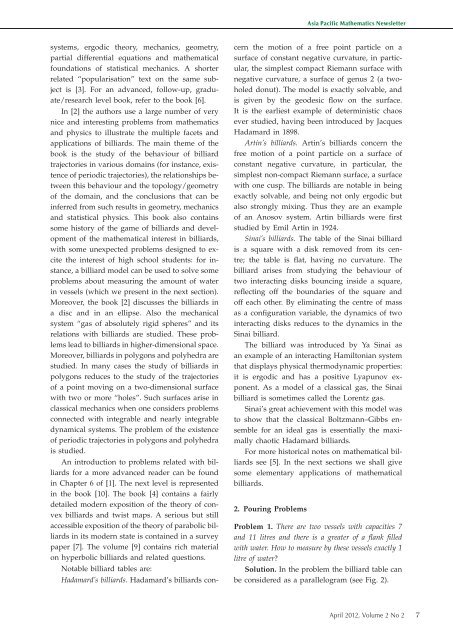Mathematics Newsletter
Mathematics Newsletter
Mathematics Newsletter
You also want an ePaper? Increase the reach of your titles
YUMPU automatically turns print PDFs into web optimized ePapers that Google loves.
systems, ergodic theory, mechanics, geometry,<br />
partial differential equations and mathematical<br />
foundations of statistical mechanics. A shorter<br />
related “popularisation” text on the same subject<br />
is [3]. For an advanced, follow-up, graduate/research<br />
level book, refer to the book [6].<br />
In [2] the authors use a large number of very<br />
nice and interesting problems from mathematics<br />
and physics to illustrate the multiple facets and<br />
applications of billiards. The main theme of the<br />
book is the study of the behaviour of billiard<br />
trajectories in various domains (for instance, existence<br />
of periodic trajectories), the relationships between<br />
this behaviour and the topology/geometry<br />
of the domain, and the conclusions that can be<br />
inferred from such results in geometry, mechanics<br />
and statistical physics. This book also contains<br />
some history of the game of billiards and development<br />
of the mathematical interest in billiards,<br />
with some unexpected problems designed to excite<br />
the interest of high school students: for instance,<br />
a billiard model can be used to solve some<br />
problems about measuring the amount of water<br />
in vessels (which we present in the next section).<br />
Moreover, the book [2] discusses the billiards in<br />
a disc and in an ellipse. Also the mechanical<br />
system “gas of absolutely rigid spheres” and its<br />
relations with billiards are studied. These problems<br />
lead to billiards in higher-dimensional space.<br />
Moreover, billiards in polygons and polyhedra are<br />
studied. In many cases the study of billiards in<br />
polygons reduces to the study of the trajectories<br />
of a point moving on a two-dimensional surface<br />
with two or more “holes”. Such surfaces arise in<br />
classical mechanics when one considers problems<br />
connected with integrable and nearly integrable<br />
dynamical systems. The problem of the existence<br />
of periodic trajectories in polygons and polyhedra<br />
is studied.<br />
An introduction to problems related with billiards<br />
for a more advanced reader can be found<br />
in Chapter 6 of [1]. The next level is represented<br />
in the book [10]. The book [4] contains a fairly<br />
detailed modern exposition of the theory of convex<br />
billiards and twist maps. A serious but still<br />
accessible exposition of the theory of parabolic billiards<br />
in its modern state is contained in a survey<br />
paper [7]. The volume [9] contains rich material<br />
on hyperbolic billiards and related questions.<br />
Notable billiard tables are:<br />
Hadamard’s billiards. Hadamard’s billiards con-<br />
Asia Pacific <strong>Mathematics</strong> <strong>Newsletter</strong><br />
2<br />
cern the motion of a free point particle on a<br />
surface of constant negative curvature, in particular,<br />
the simplest compact Riemann surface with<br />
negative curvature, a surface of genus 2 (a twoholed<br />
donut). The model is exactly solvable, and<br />
is given by the geodesic flow on the surface.<br />
It is the earliest example of deterministic chaos<br />
ever studied, having been introduced by Jacques<br />
Hadamard in 1898.<br />
Artin’s billiards. Artin’s billiards concern the<br />
free motion of a point particle on a surface of<br />
constant negative curvature, in particular, the<br />
simplest non-compact Riemann surface, a surface<br />
with one cusp. The billiards are notable in being<br />
exactly solvable, and being not only ergodic but<br />
also strongly mixing. Thus they are an example<br />
of an Anosov system. Artin billiards were first<br />
studied by Emil Artin in 1924.<br />
Sinai’s billiards. The table of the Sinai billiard<br />
is a square with a disk removed from its centre;<br />
the table is flat, having no curvature. The<br />
billiard arises from studying the behaviour of<br />
two interacting disks bouncing inside a square,<br />
reflecting off the boundaries of the square and<br />
off each other. By eliminating the centre of mass<br />
as a configuration variable, the dynamics of two<br />
interacting disks reduces to the dynamics in the<br />
Sinai billiard.<br />
The billiard was introduced by Ya Sinai as<br />
an example of an interacting Hamiltonian system<br />
that displays physical thermodynamic properties:<br />
it is ergodic and has a positive Lyapunov exponent.<br />
As a model of a classical gas, the Sinai<br />
billiard is sometimes called the Lorentz gas.<br />
Sinai’s great achievement with this model was<br />
to show that the classical Boltzmann–Gibbs ensemble<br />
for an ideal gas is essentially the maximally<br />
chaotic Hadamard billiards.<br />
For more historical notes on mathematical billiards<br />
see [5]. In the next sections we shall give<br />
some elementary applications of mathematical<br />
billiards.<br />
2. Pouring Problems<br />
Problem 1. There are two vessels with capacities 7<br />
and 11 litres and there is a greater of a flank filled<br />
with water. How to measure by these vessels exactly 1<br />
litre of water?<br />
Solution. In the problem the billiard table can<br />
be considered as a parallelogram (see Fig. 2).<br />
April 2012, Volume 2 No 2 7


